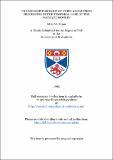The neurophysiology of form and motion processing in the temporal lobe of the macaque monkey
Abstract
Consideration of available evidence suggests that primate vision utilises two parallel cortical pathways to process visual information. The ventral pathway processes form or shape information, while the dorsal pathway processes motion information. In the macaque monkey, the superior temporal sulcus in the temporal lobe is one of the few cortical areas that receives input from both these pathways. In this thesis recordings from visually responsive neurons in the macaque superior temporal sulcus are described. The cell response properties of three cell groups are investigated. One cell population show selectivity for the sight of static images of particular views of the body. The second group of cells shows selectivity for the sight of objects moving in the environment, independent of the object's form. The final group of cells show selectivity for particular views of the body providing that they are moving in particular directions. The responses from these three groups of cell types are subjected to an analysis technique that allows insights into possible computational processes underlying the observed neural selectivity's. In particular, it is argued that the primate visual system processes form information primarily in a feedforward way, a property few computational models of visual processing employ. These data are combined with data from other studies to produce a speculative outline for a biologically plausible model of primate visual form processing. The recordings also revealed cell responses to walking bodies that showed a remarkable selectivity for "structure from motion". It is suggested that this selectivity is developed by associative learning between the initially separate form and motion inputs. Investigation of the integration of form and motion information onto single cells indicated a hitherto unforeseen problem: a temporal asynchrony between the arrival times of form and direction information. This asynchrony indicates that previously proposed mechanisms for binding of information about the same object are incorrect.
Type
Thesis, PhD Doctor of Philosophy
Collections
Items in the St Andrews Research Repository are protected by copyright, with all rights reserved, unless otherwise indicated.

